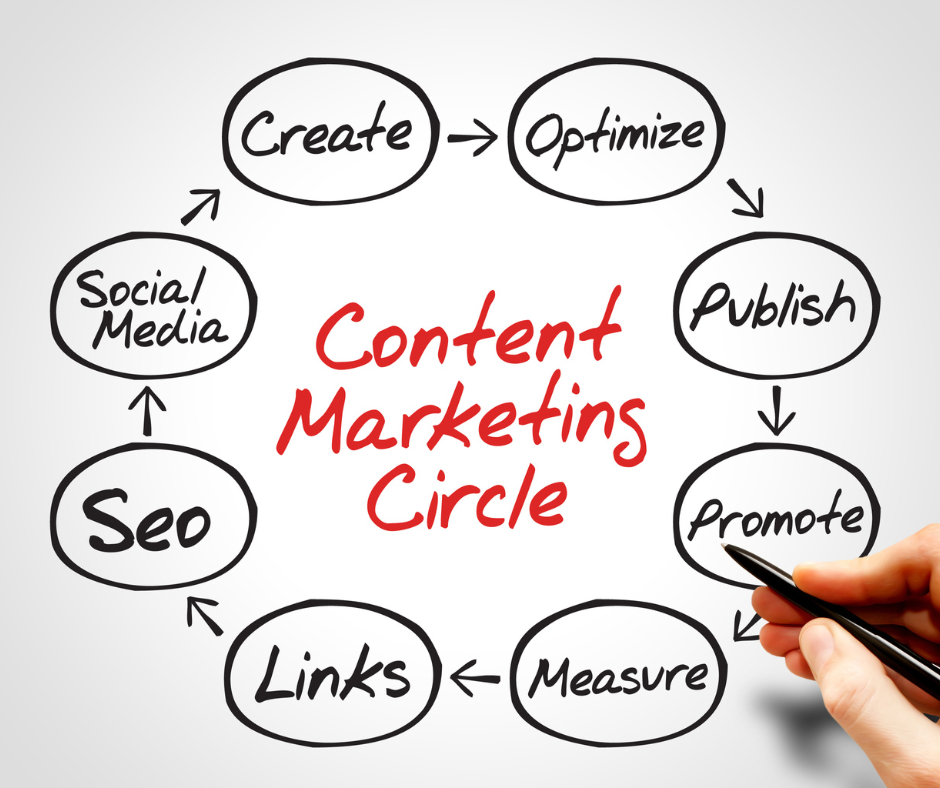In the arena of digital marketing, content is king. And content marketing is creating and sharing valuable content to attract and engage a target audience. But what does that mean for your business? How do you start making content that keeps people interested and helps you reach your marketing goals? This article will teach you everything you need to know about content marketing, from the basics to developing a successful strategy. So read on and get ready to learn about content marketing!
What is Content Marketing?
Content marketing is the process of making and sharing content that helps your business or organization reach the people it wants to reach. It’s a way to plan and carry out marketing plans that use digital media like websites, social media accounts, emails, and videos. Content must be relevant to your audience and useful for it to be effective.

Content marketing, unlike other ways of marketing that focus on selling products or services, tries to earn customers’ trust and attention by talking to them in a respectful way. By delivering high-quality, informative, educational, or entertaining content that appeals to target audiences’ interests, content marketers hope to establish mutually beneficial relationships with customers that encourage long-term brand loyalty.
Quality content builds trust between brands and consumers while increasing website traffic and driving conversions. To achieve these objectives, marketers must carefully plan and execute their strategies from start to finish. Creating quality content takes time, effort, and energy—but if done correctly, it can be extremely rewarding for both brands and their customers.
Types Of Content Marketing:
1. Online Content Marketing
Online content marketing is a strategic marketing approach focused on creating and publishing material online to attract and engage customers. This can include anything from your company website to blog posts, social media updates, and infographics.
The main goal of online content marketing is to create engaging and helpful content for your target audience. When done correctly, this content can serve as a valuable resource for customers, helping to establish your business as a credible source of information.
2. Social Media
Social media content marketing is the process of creating and publishing material on social media platforms with the intention of attracting and engaging customers. This could be in the form of posts on Facebook, tweets on Twitter, pins on Pinterest, or updates on LinkedIn or Instagram.
The purpose of social media marketing is to attract people to your social media profiles, where they can learn more about your company and its products or services.
3. Infographic Content Marketing
Infographics are a type of visual content that display information, data, or other content in an easy-to-understand format. They can be used to explain complex or hard topics in a simple way or to share statistics and data about a particular topic. Infographics are often used in blog posts or as social media updates.
The purpose of infographic content marketing is twofold: firstly, it’s intended to educate potential customers about a particular topic; secondly, it’s meant to generate interest in your company or product. Infographics are an effective way to get your information across quickly and effectively while also being visually appealing. As such, they can be a great way to attract attention online.
4. Blogging
Blogs are a type of inbound content that allows for a lot of creativity in terms of their purpose and topic. A business or company blog can be used for a variety of purposes: it can act as a resource for customers (providing information about products or services), as an educational tool (teaching people about various aspects of the business), or as a platform for sharing news and insights about the company or industry.
Today, nearly 60 million WordPress blogs exist (and that number is growing by the day). If a business doesn’t have a blog as part of its content marketing strategy, it’s missing out on a huge opportunity to connect with its target audience. Fortunately, for those lacking the time and resources to maintain a blog, a blog writing service can be a game-changer. By outsourcing the task to experts, businesses can ensure consistent, high-quality content that engages readers and boosts their online presence, ultimately leading to increased brand awareness and customer engagement.
When used correctly, blogs can be an extremely effective way to attract online attention and generate business leads. In fact, according to HubSpot research, businesses that blog regularly see 55% more website visitors than those that don’t blog at all. Blog content marketing examples: Hubspot, Content Marketing Institute, Traveling Mitch, etc.
Six essential elements of a content marketing strategy
1. A Clear Understanding of Your Business Goals
Before you can create an effective content marketing strategy, you need to have a clear understanding of your business goals. What are you trying to achieve with your content? Do you want to increase brand awareness, generate leads, or drive sales? Once you know your desired goals, you can create content that is aligned with them.
2. A Buyer Persona or Target Audience
Who are you creating content for? You need to understand clearly defined audiences or buyer personas. What are their demographics? Their interests? What are their pain points? When you know who you’re creating content for, you can create material that appeals to them.

3. The Buyer’s Journey
The buyer’s journey is your target audience’s process when making a purchase decision. It has three parts: awareness, consideration, and decision. Your content should be created with the buyer’s journey in mind so that it speaks to your audience at every stage of the process.
4. A Content Calendar
A content calendar will help you plan, organize, and publish your content on a regular basis. Having a calendar will keep you on track and help ensure that your content is timely and relevant. Without a calendar, it’s easy to let your content marketing efforts fall by the wayside.
5. Create compelling content
This is perhaps the most important element of a successful content marketing strategy—if your content isn’t compelling, no one will read it. So focus on creating high-quality, original content that will resonate with your target audience. The best way to do this is to focus on solving your audience’s problems—if you can provide them with valuable information that helps them overcome a challenge they’re facing, they’re more likely to keep coming back for more. This review comparing Surfer SEO vs Clearscope aims to assist you in determining the most suitable tool for enhancing your page content. Additionally, this tool assigns a score to the finalized content, taking into account factors such as word count, search volume, and readability. Furthermore, it offers valuable suggestions to enhance your content score.
6. Analytics
You need to track the performance of your content so that you can see what’s working and what isn’t. Google Analytics is a free tool that can help you do this. Make sure to set up analytics before you start publishing so that you have data to work with from the very beginning.
Benefits of Content Marketing
1. Build trust with your audience.
If you provide your audience with helpful and informative content, they will be more likely to trust you and your brand. This is because you will be seen as an expert in your field and as someone who is interested in providing value to your readers. Trust is essential in any relationship, and content marketing can help you build trust with your audience.
2. Establish relationships with your readers.
By providing helpful and informative content, you will be able to establish relationships with your readers. These relationships will be based on trust and mutual respect and will be much more valuable than relationships that are based on selling products or services.
3. Increase visits to your website or blog.
If you provide helpful and informative content, people will be more likely to share it with their friends and followers. This can help you get more people to visit your website or blog, which can lead to more sales or new subscribers.
On the other hand, If you include calls to action in your content, such as links to landing pages or free trials, you will be able to generate leads from your target audience. Once you have captured a lead, you can follow up with them via email or other means to convert them into paying customers.
4. A more engaging website:
High-quality content can also make your website more engaging for visitors. This means they’re more likely to stay on your site longer, which can reduce your bounce rate and increase the chances of them taking action (such as making a purchase). You have to build trust and authority with your audience when you provide relevant, helpful, and informative content. This could make them more likely to work with you in the future.
5. Save money on paid advertising.
Content marketing is often less expensive than other forms, such as paid or traditional advertising. Additionally, it can be more effective than other forms of marketing, meaning that you will get a higher return on investment for your content marketing efforts. Because content marketing costs 62% less than traditional marketing methods, you’re likely to see a greater return on investment (ROI). This means more leads and customers for your business at a lower cost.
SEO and marketing strategies
Content marketing and SEO are two of the most important strategies you can use to improve your online presence. Good SEO starts with quality content that is keyword rich and informative. Then, once your content is published, you need to promote it to get people to see it. That’s where SEO comes in.

By optimizing your website and your content for the search engines, you can appear higher in the search results and get more traffic to your site. But SEO is only part of the story. To really succeed at content marketing, you need to have a strategy that encompasses both SEO and social media. By promoting your content across multiple channels, you can reach a larger audience and build a community of followers who will help spread the word about your brand.
When creating content, it’s important to include the right keywords to attract more traffic from search engines. But how do you know which keywords to use?
One way to find good keywords is to use Google AdWords Keyword Planner. This tool lets you see how many people are searching for a particular keyword each month. It also shows you related keywords and other information that can help you choose the right keywords for your content.
Another way to find keywords is to look at your competitor’s websites. What words and phrases are they targeting in their SEO efforts? What can you learn from them?
Once you have a low-competition list of keywords, it’s important to include them in your content. But don’t overdo it! Including too many keywords can hurt your SEO efforts. A decent guideline is to incorporate 2% to 4% of your total word count.
So, how do you know if your content is optimized for SEO? Some important things to look for are:
-A title tag including your target keyword
-The meta description includes your target keyword
-Your content includes your target keyword throughout the text
Wrap Up
In the end, there is no doubt that content marketing can help your business skyrocket. However, a good plan and consistent efforts are needed to guarantee success in this area. As always, don’t forget to follow the practices laid out in this article to ensure success. With such reliable techniques, you will be able to create content worth sharing with your audience in no time.









